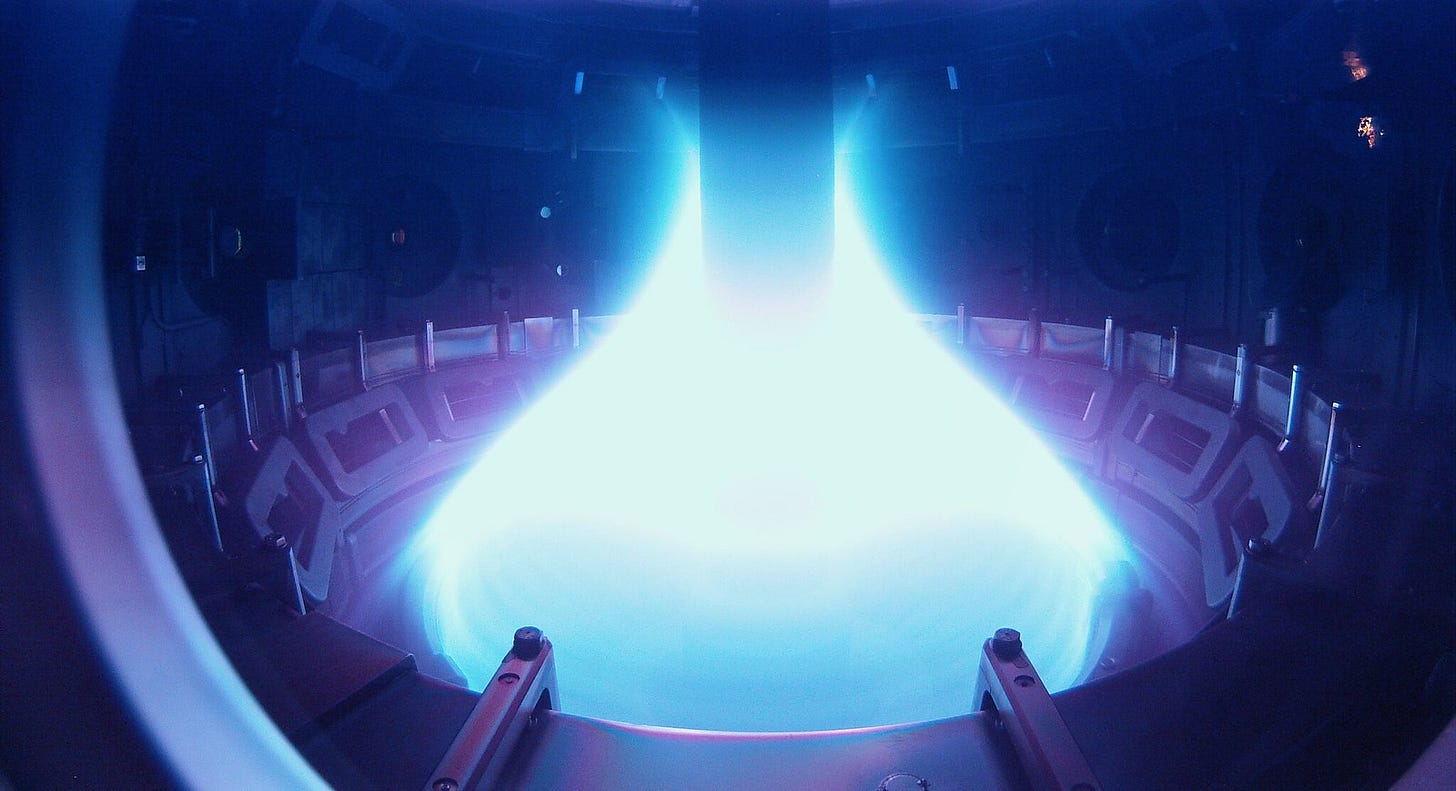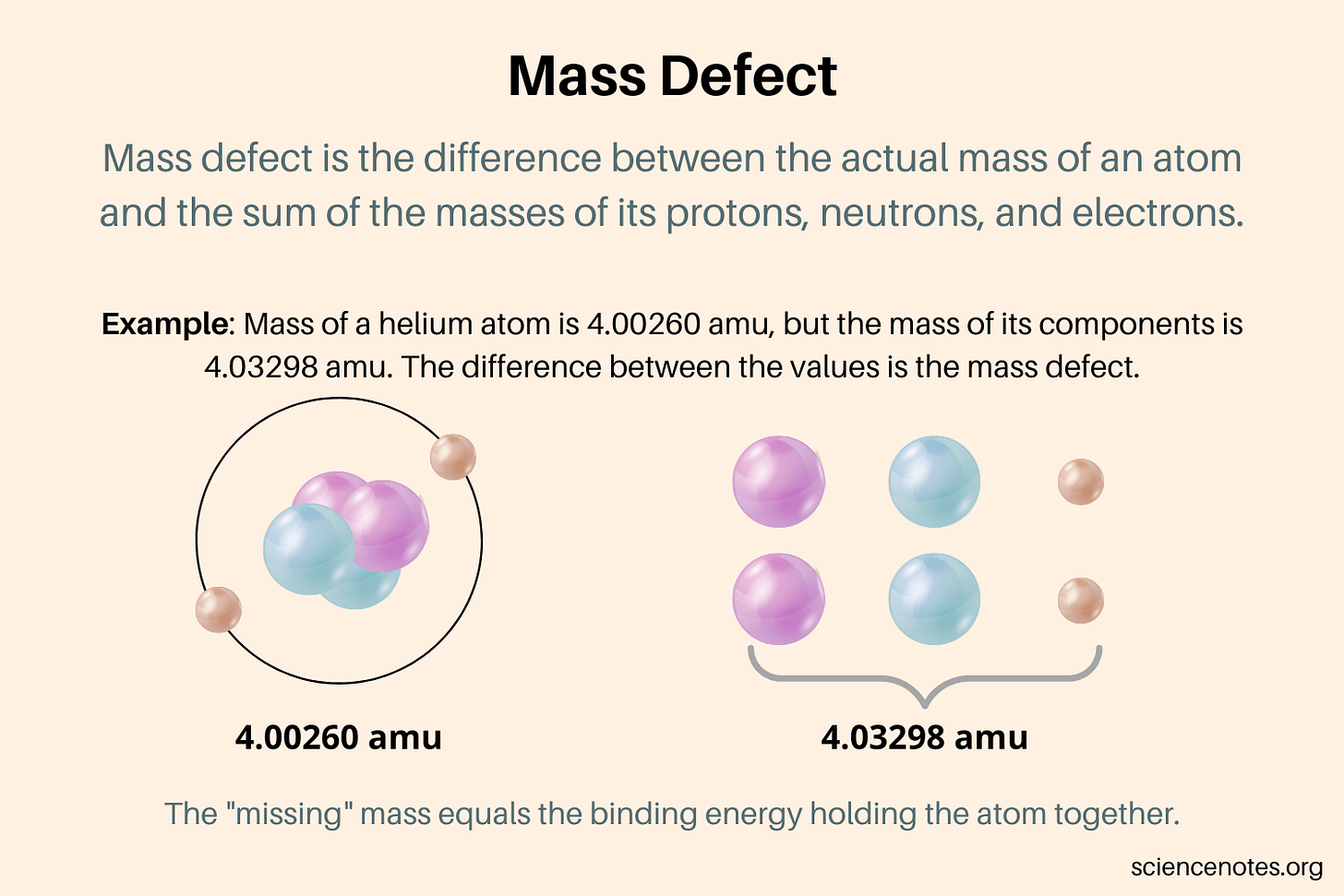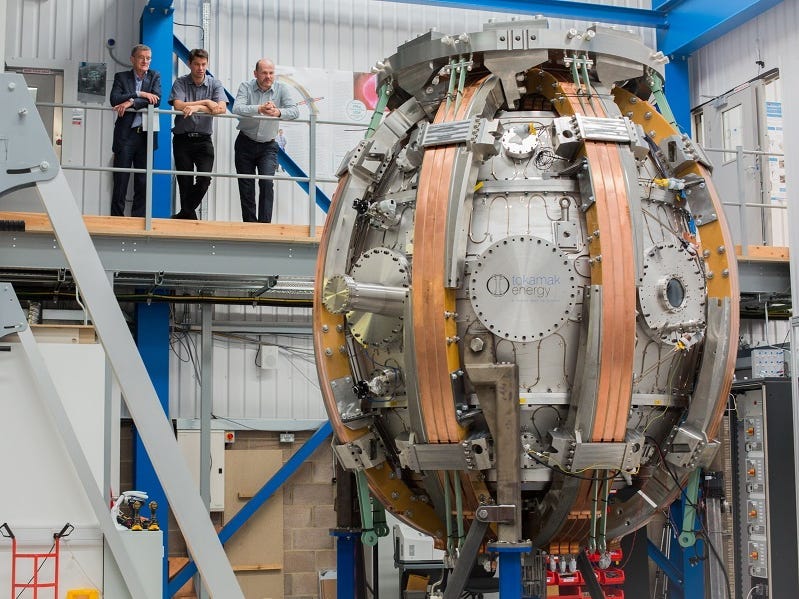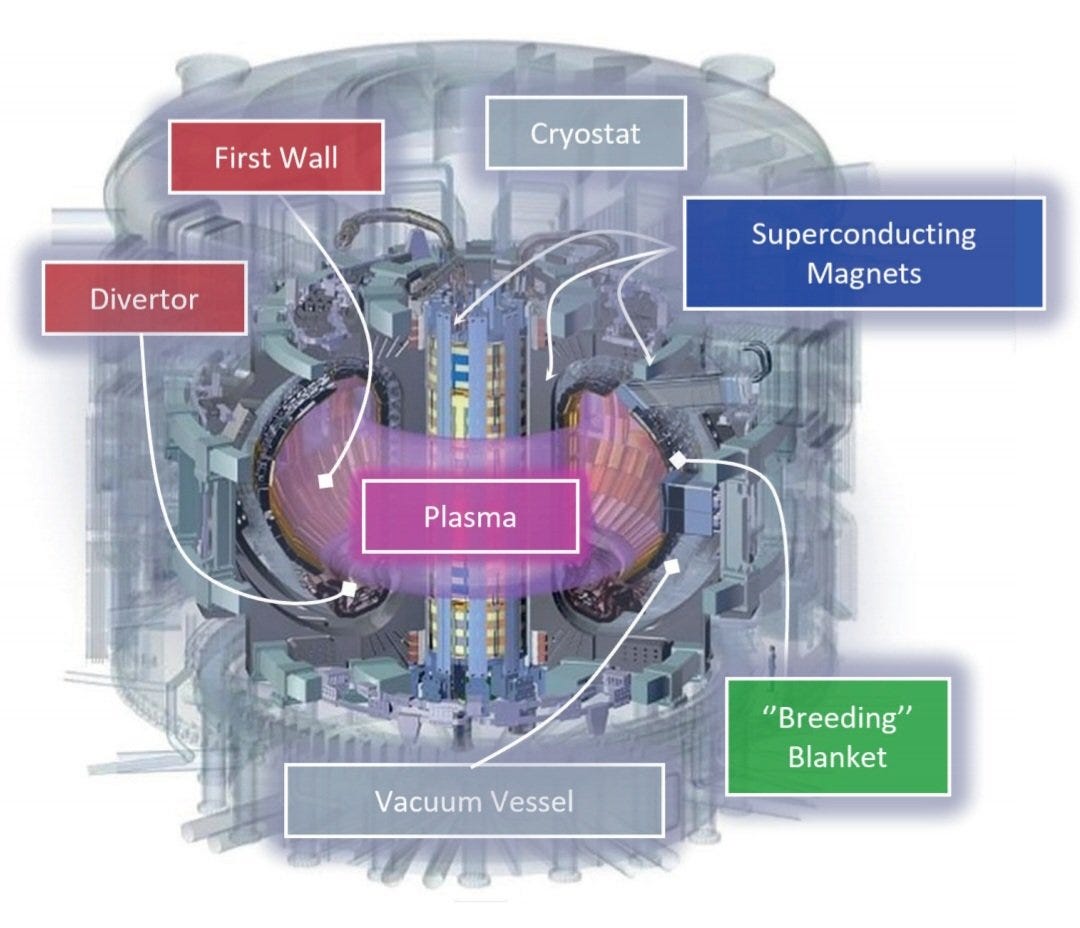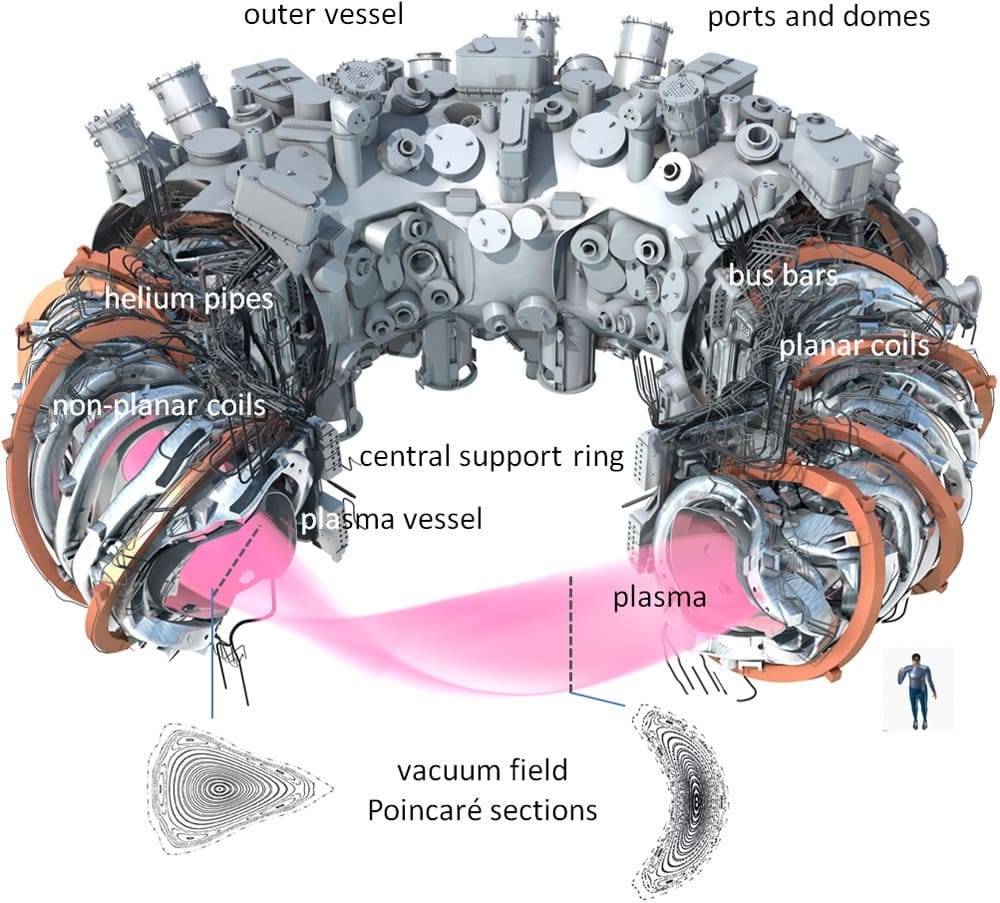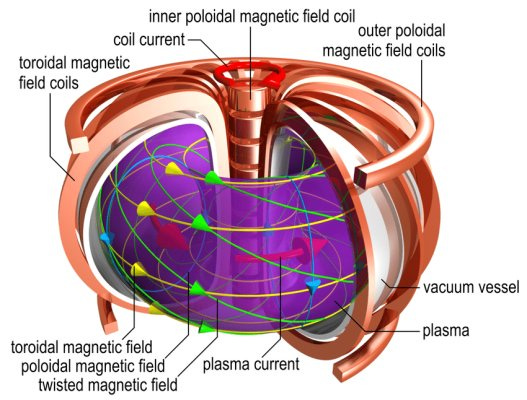A couple of months ago, in a dull Tungsten & Beryllium doughnut in Cadarache, France, a wispy ring of plasma flashed into fusion fire. For 22 minutes it was the hottest thing in the solar system, before guttering out like God's own candle.
22 minutes is a long time to do anything really difficult, but it also seems a bit short, since fusion energy has been under development for decades now. What's so god-damned difficult about it?
If you want to find out, you're in the right place…
1: Mass Defect
Let's immediately lose half of my readership by talking about atoms! We're going to cover the mass defect and what nuclear fusion is. If you already know the details, skip to the later chapters for the chunky engineering stuff.
For everyone else, let's go Quantum.
The mass defect isn't a computer game, though it sounds like it, but a real fundamental oddity in physics. Combine two light elements, like hydrogen isotopes, together into a bigger one like a helium atom and the mass of the new creation is very slightly lower than the total mass of all its constituent parts.
It's like building a house and finding that the house weighs fifty bricks less when you finish… but every brick is accounted for. Where did that mass go?
This is the mass defect.
The mass defect is also known by the “nucleon binding energy”, or energy required to break apart the nucleus. This rises steeply as you fuse lighter elements together, all the way to iron at the peak, which is spectacularly stable. If you fuse light elements like hydrogen isotopes together to climb this slope, the energy difference is released.
And it's gigantic!
This is why fusion power is attractive: A potentially colossal energy yield out of tiny amounts of fuel. That and no awkward radioactive fuel, automatic safety (turn it off and the reaction stops instantly), no weapons proliferation risk etc. Brilliant!
The only downside is that it's a tad difficult.
And by “a tad”, be sure that I'm leveraging British understatement to its fullest extent. This is a biggie.
Still, you can't deny that it's inspirational.
2: The sun: Giant compost heap in the sky.
I stand by the lakeside and squint at clouds through cool air. Above, Greenane looks down its craggy mountain nose at its twin in the lake.
The sun parts the clouds and I jerk my eyes down to the inky surface of lake Muskry, blinded and trying to be inspired.
Rather annoyingly, hydrogen isotopes don't like being smashed together and fiercely resist fusing into higher elements. Stubborn little devils. That's why here on earth we need horrifically powerful technological wonder-machines, super magnets and the hottest temperatures for many light years around.
So how does the sun manage it without any special equipment?
The sun has something we don't, which is 2 billion billion billion tons of hydrogen. Basically it's bloody massive.
And a billion years: The fusion of any individual pair of hydrogen atoms, zinging around inside their star core, is so unlikely that you either need to up the temperature (to make them hit harder and have a higher chance to overcome resistance), be at very high density (to increase the number of collisions) and to keep it up for a long period of time. We have to remember that for all its life-sustaining vitality, on average the core of the sun only has a power density of 277 Watts per cubic metre, which is about the same as a large compost heap. That's one of the reasons it's been burning so long.
Here on earth, we don't have a billion years or endless hydrogen, so the only dials we have left are density and -especially- temperature. And a compost heap just isn't enough for a power plant.
Which is why the inside of a fusion reactor is the hottest thing in the solar system. It needs to be.
I stare too long at reflected mountain crags and grow bored.
Kicking rocks, I look down at my phone screen.
3: Wick the infinite candle.
How do you contain the hottest thing in the world, and why does it need to be so hot anyway?
Our goal is to achieve fusion ignition, which is the point at which the energy released by fusion in a volume is sufficient to trigger yet more fusion in a self-perpetuating reaction, like a candle burning. This ignition point is defined by something called the Lawson Triple Product, which can loosely be defined as ion electron volts (temperature) multiplied by ion density multiplied by confinement time. This density-temperature-time product is the primary factor that fusion engineers have spent over half a century trying to improve.
For the most common form of fusion reactor, the magnetic confinement tokamak, the temperature you need to reach for ignition is a completely insane 150 MILLION degrees Celsius! This is the type of reactor we’ll discuss here, and these stupefying numbers beg the question: How do you contain something so hot that it would vaporize any known material pretty much instantly?
The obvious answer is: You don’t use any known material. You use magnetism.
Fusion Dreams
ITER, a colossal techno-cathedral being built in the sunny South of France, is a project to cage the power of a star on Earth. It's also likely to cost 22 billion Euros, though somehow that doesn't matter as much.
4: A Soviet supermachine and the Culham five.
In 1965, something beyond incredible came out of the Soviet Union.
Reports arrived of a toroidal fusion device with a plasma temperature more than ten times higher than anything achieved in a West. The results were greeted with cynicism, but they kept on coming. In 1968, while Americans closed on the moon, the USSR opened its borders and research labs to a team of specialists to verify this incredible temperature directly. Nicknamed the Culham Five, the British specialists used a pioneering plasma temperature measurement technique called Thomson Scattering to verify the unbelievable results coming out of the Russian reactor.
It was true. The Soviets had birthed the tokamak, and created a unique approach to stabilizing fusion plasma.
If you loop a solenoid of superconducting magnets into a doughnut shape you will also loop the magnetic field lines. Charged particles will spiral around these field lines, locked forever and endlessly chasing their own tail, approaching infinity by endless procession.
This much wasn't new, but it was in the stabilization of the trapped hydrogen fuel that the Russians had found something different.
Heat hydrogen fuel until it becomes a plasma, the state of matter where a substance is so manically energised that its atoms & electrons disassociate and buzz off to do their own things separately, and they'll be magnetically captured. The electrons, with their negative charge, spiral one way around the magnetic field lines. The positively charged nuclei spiral the other way. Possibly they wave as they pass each other, I don’t know.
The problem, of course, is that it’s never that simple. Due to particle drift in the torus, the plasma ring becomes unstable very quickly and hits the walls, extinguishing itself, so you need something else. The “something else” is a rotational transform, in which you twist the toroidal magnetic field into a helix: With each particle now dancing elaborate looping figure-8s, this effectively cancels out particle drift and helps keep the whole thing stable.
Lovely. Great. But we can't stick an oar into the roaring plasma stream, so how can you twist it?
If you want, you can do it by physically twisting the superconducting magnets through Escher-esque contortions to form a stellarator, a special kind of fusion reactor shown above, but the more conventional way to create a helical field, which the Russian tokamak employed, is to use a pulsed solenoid (here labelled as an inner poloidal field coil).
The plasma fuel in a fusion reactor isn’t just toasty warm, it’s also an electrical conductor. If you can induce an electrical current in the plasma loop, the interaction of that electrical current with the toroidal magnetic field will create a rotational transform, twisting the field into a helix. -And this helix will then cancel out the plasma drift and stabilize the magnetic trap, letting you hold onto your bottle of star stuff.
This sounds complicated, and you’re not wrong to think that. For a start, creating an electrical current in something too hot to touch seems like an impossibility, but fortunately you can employ trickery: For if you build a colossal solenoid coil in the middle of the torus and ramp a current through it, then the changing flux between the solenoid (many coils) and the plasma loop (one coil) acts like a gigantic step-down transformer, inducing a mighty electrical current in it… and so the magnetic field lines are twisted and the plasma stabilizes.
This doesn't work for long, as you can't ramp the current in the solenoid infinitely, and so a tokamak works by pulsing.
The fuel plasma is now stuck in an endless loop. Congratulations! You've wicked the infinite candle.
Now we must light it…
Keep reading with a 7-day free trial
Subscribe to Incautious Optimism to keep reading this post and get 7 days of free access to the full post archives.


